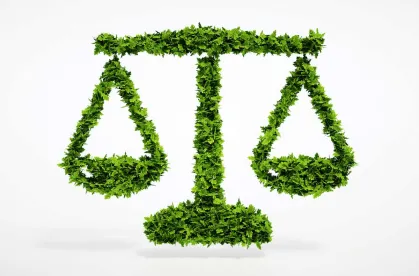Highlights
The EPA is soliciting applications for the design and management of its new Environmental Justice competitive pass-through program
Pursuant to the Inflation Reduction Act, the EPA is making $550 million available to up to 11 pass-through grantmakers for projects addressing local environmental and public health issues in underserved communities
The deadline for submittal of applications is May 31, 2023
On Feb. 23, 2023, the Biden administration announced the availability of $550 million to expedite investments through the U.S. Environmental Protection Agency’s (EPA) new Environmental Justice Thriving Communities Grantmaking program. The funding will come from the $3 billion included for environmental justice block grants authorized by the Inflation Reduction Act.
Application packages must be submitted on or before May 31, 2023. The EPA has posted an informational video on the environmental and climate justice communities grants program and will be conducting a webinar on March 16, 2023, to address questions about the grantmaker program and the Request for Applications (RFA).
This RFA is being launched to meet the goals and objectives of two executive orders (EO 14008 and EO 13985) issued by the Biden administration that demonstrate the EPA’s and the administration’s commitment to achieving environmental justice and embedding environmental justice into agency programs.
The EPA plans to award up to 11 cooperative agreements for as much as $50 million each to pass-through entities (referred to as grantmakers by the program) that will make subgrants to community-based projects that reduce pollution. (Those subgrants will be subawards consistent with the definition of that term in 2 CFR 200.1.) Ten will be regional grantmaker awards (i.e., for each of the EPA regions), and one will be a nationwide award to a national grantmaker, who will provide coordination services for the regional grantmakers and fill gaps in coverage. The funding of each grantmaker will be incremental over a three-year period. No cost sharing or matching is required as a condition of eligibility.
Grantmakers will come from the following four categories:
-
A community-based nonprofit organization, such as a public or private nonprofit organization that supports and/or represents a community and/or certain populations within a community through engagement, education and other related services provided to individual community residents and community stakeholders. (However, nonprofit organizations described in Section 501(c)(4) of the Internal Revenue Code that engage in lobbying activities as defined in Section 3 of the Lobbying Disclosure Act of 1995 are not eligible to apply.)
-
A partnership of community-based nonprofit organizations
-
A partnership between a tribal nation and a community-based nonprofit organization
-
A partnership between an institution of higher education and a community-based nonprofit organization
The EPA strongly encourages all minority serving institutions (MSI) – institutions of higher education that serve minority populations – and university business schools and business programs to apply to become a grantmaker. For purposes of this RFA, MSIs include: Historically Black Colleges and Universities, tribal colleges and universities, Hispanic-serving institutions, Asian American and Native American Pacific Islander-serving institutions, and predominately Black institutions.
The following entities are not eligible to be a pass-through grantmaker under this RFA: state and local governments and their agencies and instrumentalities, U.S. territories and possessions; hospitals, quasi-governmental entities (e.g., water districts, utilities), for-profit businesses’ international organizations, or individuals
According to the RFA, the EPA will enter into cooperative agreements with grantmakers who will collaborate with the EPA to design and build their own processes to receive and evaluate competitive community project applications from communities for Environmental Justice Thriving Communities subgrants for projects and capacity building efforts addressing local environmental and public health issues. Grantmakers will be accountable to the EPA for proper expenditure of the funds, reporting on the overall progress and deliverables of the program, and providing regular status reports and updates on all subgrants.
The EPA expects grantmakers to begin awarding subgrants to community-based organizations no later than early 2024. According to the EPA:
“These awards will help transform disadvantaged and underserved communities into healthy, thriving communities capable of addressing the environmental and public health challenges they have historically faced, as well as current and future challenges. Additionally, these awards are part of the Federal Partnership supporting the Thriving Communities Network initially funded through the environmental Consolidated Appropriations Act of 2022.”
The EPA further explains that, per EO 13985, the underserved and disadvantaged communities these projects are intended to serve include:
“…populations sharing a particular characteristic, as well as geographic communities, that have been systematically denied a full opportunity to participate in aspects of economic, social, and civic life…” This includes communities “such as Black, Latino, and Indigenous and Native American persons, Asian Americans and Pacific Islanders and other persons of color; members of religious minorities; lesbian, gay, bisexual, transgender, and queer (LGBTQ+) children, the elderly, members of religious minorities; lesbian, gay, bisexual, transgender, and queer (LGBTQ+) persons; persons with disabilities; persons who live in rural areas; and persons otherwise adversely affected by persistent poverty or inequality.” For purposes of this RFA, “underserved communities” also includes “environmentally overburdened communities” (that is, communities adversely and disproportionately affected by environmental, climate and human health harms and risks including remote, rural, and urban communities), and disadvantaged communities.
Eligible subrecipients include:
-
Nonprofit organizations
-
Community-based and grassroots nonprofit organizations
-
Philanthropic and civic organizations with nonprofit status
-
Tribal governments (both federally recognized and state-recognized) and intertribal consortia (i.e., a partnership between two or more tribes that work together to achieve a common objective.)
-
Native American organizations (includes Indian groups, cooperatives, nonprofit corporations, partnerships, and associations that have the authority to enter into legally binding agreements)
-
Puerto Rico
-
U.S. territories
-
Freely Associated States – including local governmental entities and local nonprofit organizations in the Federated States of Micronesia, the Republic of the Marshall Islands, and Palau
Individuals, for-profit businesses, and state governments are not eligible to be subrecipients.
One of the more important aspects of the program identified by the EPA will be documentation of the capacity built and other changes achieved by both the subrecipients and the grantmakers. This will include sharing information about subrecipient successes and lessons learned, as well as the grantmakers’ ability to respond to and meet the needs of communities most impacted by environmental injustices.






 />i
/>i

